The Sons of the Pioneers are one of the United States' earliest Western singing groups. Known for their vocal performances, their musicianship, and their songwriting, they produced innovative recordings that have inspired many Western music performers and remained popular through the years. Since 1933, through many changes in membership, the Sons of the Pioneers have remained one of the longest-surviving country music vocal groups.
Western music is a form of country music composed by and about the people who settled and worked throughout the Western United States and Western Canada. Western music celebrates the lifestyle of the cowboy on the open ranges, Rocky Mountains, and prairies of Western North America. Directly related musically to old English, Irish, Scottish, and folk ballads, also the Mexican folk music of Northern Mexico and Southwestern United States influenced the development of this genre, particularly corrido, ranchera, New Mexico and Tejano. Western music shares similar roots with Appalachian music, which developed around the same time throughout Appalachia and the Appalachian Mountains. The music industry of the mid-20th century grouped the two genres together under the banner of country and western music, later amalgamated into the modern name, country music.
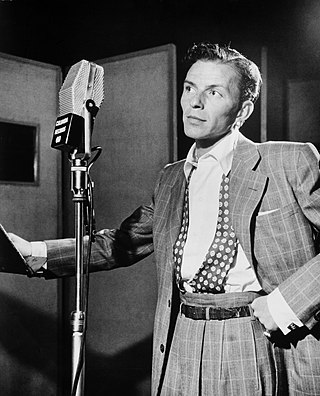
Crooner is a term used to describe primarily male singers who performed using a smooth style made possible by better microphones which picked up quieter sounds and a wider range of frequencies, allowing the singer to access a more dynamic range and perform in a more intimate manner. It is derived from the old verb "to croon". This suggestion of intimacy was supposedly wildly attractive to women, especially younger ones such as teenage girls, known at the time as "bobby soxers". The crooning style developed out of singers who performed with big bands, and reached its height in the 1940s to late 60s.
"Enjoy Yourself (It's Later Than You Think)" is a popular song published in 1949, with music written by Carl Sigman and lyrics by Herb Magidson.
"Lullaby of Broadway" is a popular song with music written by Harry Warren and lyrics by Al Dubin, published in 1935. The lyrics salute the nightlife of Broadway and its denizens, who "don't sleep tight until the dawn."

A singing cowboy was a subtype of the archetypal cowboy hero of early Western films. It references real-world campfire side ballads in the American frontier, the original cowboys sang of life on the trail with all the challenges, hardships, and dangers encountered while pushing cattle for miles up the trails and across the prairies. This continues with modern vaquero traditions and within the genre of Western music, and its related New Mexico, Red Dirt, Tejano, and Texas country music styles. A number of songs have been written and made famous by groups like the Sons of the Pioneers and Riders in the Sky and individual performers such as Gene Autry, Roy Rogers, Tex Ritter, Bob Baker and other "singing cowboys". Singing in the wrangler style, these entertainers have served to preserve the cowboy as a unique American hero.
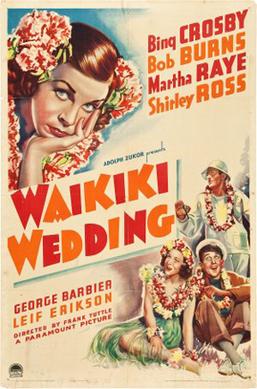
Waikiki Wedding is a 1937 American musical film directed by Frank Tuttle and starring Bing Crosby, Bob Burns, Martha Raye, and Shirley Ross. Crosby plays the part of Tony Marvin, a PR man charged with extolling the virtues of the Territory of Hawaii. The female lead, played by Shirley Ross is a local beauty queen who makes unhelpful comments about the islands. Bob Burns, along with Martha Raye, are the "comic relief". Amongst the supporting cast was a young Anthony Quinn. It was made by Paramount Pictures as a rival to the Fred Astaire and Ginger Rogers films then being made by RKO Pictures.
"Don't Fence Me In" is a popular American song written in 1934, with music by Cole Porter and lyrics by Robert Fletcher and Cole Porter. Members of the Western Writers of America chose it as one of the Top 100 Western songs of all time.
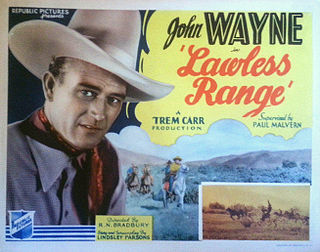
Lawless Range is a 1935 American Western film released by Republic Pictures, directed by Robert N. Bradbury and starring John Wayne. He appears as a "singing cowboy" in the film, with his singing voice dubbed by Glenn Strange, who later found lasting film fame himself as Frankenstein's Monster.

"Crazy Rhythm" is a thirty-two-bar swing show tune written in 1928 by Irving Caesar with music by Joseph Meyer and Roger Wolfe Kahn for the Broadway musical Here's Howe.

Pardners is a 1956 American comedy western film starring the comedy team of Martin and Lewis. It was released on July 25, 1956, by Paramount Pictures.
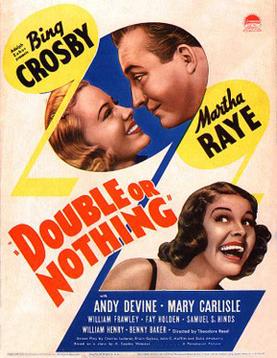
Double or Nothing is a 1937 American musical comedy film directed by Theodore Reed and starring Bing Crosby, Martha Raye, Andy Devine, Mary Carlisle and William Frawley. Based on a story by M. Coates Webster, the film is about a dying millionaire who instructs his lawyer to drop four purses on the streets of New York City, which are found and returned by four honest people. According to the will, each of them is given five thousand dollars, which they must double within thirty days in order to claim one million dollars. Greedy relatives, who were cut from the will, try to thwart each one's plans. The film features the popular song "The Moon Got in My Eyes".

This is a selection of films and television appearances by British-American comedian and actor Bob Hope (1903-2003). Hope, a former boxer, began his acting career in 1925 in various vaudeville acts and stage performances
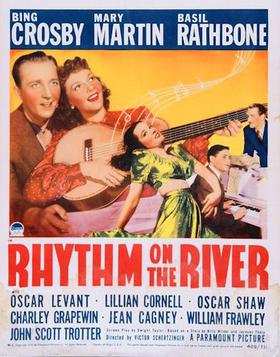
Rhythm on the River is a 1940 musical comedy film directed by Victor Schertzinger and starring Bing Crosby and Mary Martin as ghostwriters whose songs are credited to a composer played by Basil Rathbone. Crosby and Martin sang "Only Forever", for which James V. Monaco (music) and Johnny Burke (lyrics) were nominated for the Academy Award for Best Original Song.

"I'm an Old Cowhand (From the Rio Grande)" is a comic song written by Johnny Mercer for the Paramount Pictures release Rhythm on the Range and sung by its star, Bing Crosby. The Crosby commercial recording was made on July 17, 1936, with Jimmy Dorsey & his Orchestra for Decca Records. It was a huge hit in 1936, reaching the No. 2 spot in the charts of the day, and it greatly furthered Mercer's career. Crosby recorded the song again in 1954 for his album Bing: A Musical Autobiography.
Members of the Western Writers of America chose it as one of the Top 100 Western songs of all time.

Rootin' Tootin' Rhythm is a 1937 American Western film directed by Mack V. Wright and starring Gene Autry, Smiley Burnette, and Armida. Based on a story by Johnston McCulley, the film is about two cowboys who assume the identities of dead outlaws in order to stop a bunch of cattle rustlers, later discovering that the outlaws are far from dead.
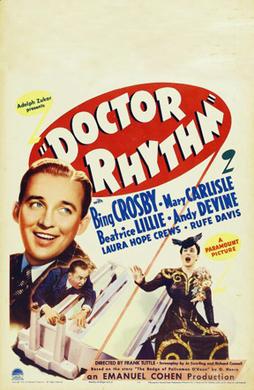
Doctor Rhythm is a 1938 American musical comedy film directed by Frank Tuttle and starring Bing Crosby, Mary Carlisle, Beatrice Lillie, and Andy Devine. Based on the 1907 short story The Badge of Policeman O'Roon by O. Henry, the film is about a doctor who pretends to be a policeman assigned as the bodyguard of a wealthy matron, whose beautiful niece becomes the object of his affections. The film features the songs "On the Sentimental Side" and "My Heart Is Taking Lessons".

"Empty Saddles (in the Old Corral)" is a classic American cowboy song written by Billy Hill. Hill based the song on a poem by J. Keirn Brennan grieving for lost companions. The song became widely known to the public in July 1936, when Bing Crosby sang it with deep emotion in the Paramount musical Rhythm on the Range, and his Decca recording of it, made on July 14, 1936, with Victor Young and His Orchestra, reached the Top 10 that September.

Cowboy Songs is a compilation album of phonograph records by Bing Crosby released in 1939 featuring Western songs.

Giulio Panicali was an Italian actor and voice actor.














